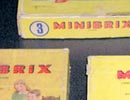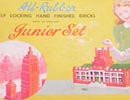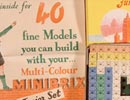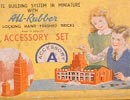
The 1950s
Malcolm Hanson
At the time of the coronation of Queen Elizabeth II in 1953 a special set was produced to mark the event. Called the 'Coronation Cabinet' it came in a beautiful wooden cabinet with several drawers and contained 5000 parts from both the standard and Tudor systems. Costing £82/0/0 plus £13/6/6 purchase tax, an enormous sum for the time; it was not surprising that very few were sold! They were clearly intended more as an advertising gimmick than a direct money making venture. At the other end of the spectrum a new conversion set, the 'X' set, was introduced which converted a No 1 set to a No. 3 set. At this time Minibrix sets were probably at their sales peak, despite costing four times their pre-war prices.
This success was not only based on home sales but also on exports. In particular the firm had an excellent market in Canada where, if anything, Minibrix were better known than they were in Britain. The Canadian importers were R.D. Fleck & Co. of Ontario and manuals were specially printed for their use with prices listed in Canadian dollars.
In about 1956 slight changes were made to the illustration on the box lids with the boy building a model now being seated in a 'contemporary' style of chair rather than the mock 'restoration' one he previously occupied! At the same time the manual was again revised with some of the Tudor model disappearing to be replaced by more of the pre-war standard models, though by this time it was significant that no entirely new models had appeared in manuals for twenty years. At about the same time a standard coloured version of the Junior set was introduced called the Starter set. It was complemented by a new conversion set, the 'S' which converted the Starter set to a No 2 set. The idea, presumably, was to try and hook them younger and with a smaller outlay for parents!
In fact the system as a whole was suffering seriously from lack of development, the post-war boom in sales having led, as so often with British firms, to a high degree of complacency. Matters were not helped by the death in March 1955 of Arnold Levy, as he had been the driving force behind I.T.S.




